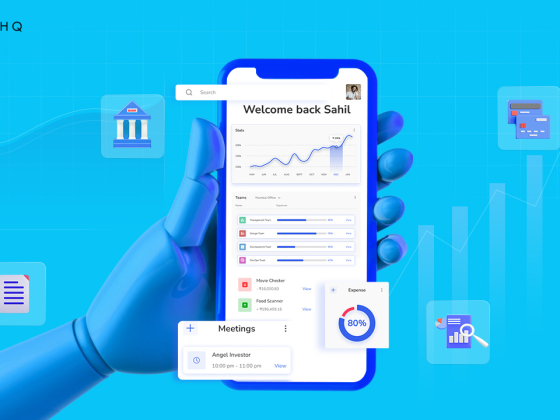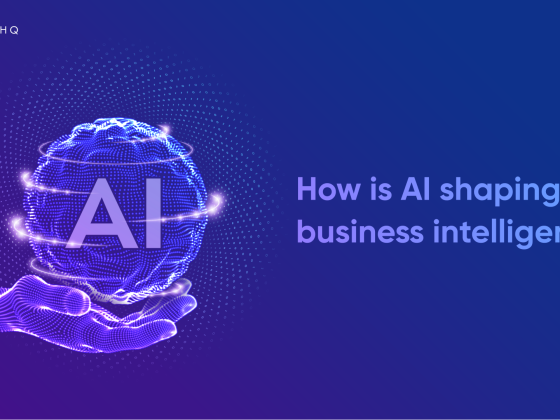What is Conversational AI?
Conversational AI is the set of technologies behind automated messaging and speech-enabled applications that offer human-like interactions between computers and humans.
There is not a single definition of conversational AI. In simple terms, it’s a technology that communicates like humans by identifying human speech & text. With a clear understanding of the intent & responding in a way that resembles human conversations.
Applied conversational AI demands both science & art to come up with a user-friendly application.
Although most businesses rely on traditional chatbots for their customer experience, conversational AI is still the most preferred technology to provide both text & voice modalities. And thus, there are various channels & devices that are compatible with these two modalities- ensuring SMS & web chat for text modality and phone & smart speakers for voice modality.
Think about the last time that you communicated with a business and you could have completed the same tasks. That’s the power of conversational AI to the best quality.
The very first online interaction comes from conversational AI, a technology that makes you feel over the moon when you connect with any digital brand. It’s meant for customers who expect not less than a 5-star experience from every business they connect with. To keep a pace ahead in the landscape of ever-evolving technologies, almost every online venture deploys an AI-powered conversational setup to enhance customer onboarding with ultimate conversational experiences.
AI and ML – The new languages

Over 95% of online interactions will take place through AI-driven systems in 2025 & conversational AI will be one of them. Aiming to connect humans and computers, it comprises a bunch of cutting-edge technologies to construct synthetic brainpower that further makes machines or chatbots capable of understanding, reading, & responding to the human language. And we call it conversational AI in technical terms.
The diverse applications of conversational AI are mounting up to transform the entire digital space. Let’s catch up with a complete guide on conversational AI, components, & use cases.
You can find the essence of conversational AI in IVR systems, messaging platforms, voice-based communication channels, chatbots, mobile apps, & many other channels. When employees usually spend 16% of their time in in-house communication & collaboration, conversational AI can reduce the time spent on such activities with automated & immediate referrals to customers’ issues, according to Bloomfire.
But still, most entrepreneurs are new to the benefits of using conversational AI to interact with users. In this article, we will define all ins and outs of conversational AI, its components, & use cases. Let’s begin with a quick overview of it.
How does Conversational AI work?
Conversational AI combines various technologies such as Automatic Speech Recognition (ASR), Natural Language Processing (NLP), Advanced Dialog management, and Machine Learning (ML) to understand, respond, & learn from every interaction.

Wondering how conversational AI works?
The mechanism of Conversational AI involved contextual dialogue driven by NLP and other complementary algorithms. As one develops a wide base of user inputs, your AI becomes more capable of recognizing patterns & making accurate predictions. Conversational Al discovers these four routes to connect with customers that will further shape the right sense of this technology:
Step 1: The first step is Input Generation, where a user shares inputs either through conversational voice or text.
Step 2: In the next step, Input Analysis is done to read the input. If the input is text-based then natural language understanding (NLU) is used to retrieve the meaning of the words provided. And If the input is speech-based then ASR automatic speech recognition is applied to transit the sound into language tokens for further analysis.
Step 3: Now the third step to understanding the mechanism of how Conversational AI works is Dialogue Management, where a natural language generation process is used to create a direct response to a query raised.
Step 4: At last, this step revolves around Reinforcement Learning, where all user inputs are analyzed to curate replies from time to time & ensure that their responses are correct & shared with the clients.
Now take your time to discuss significant components of conversational AI.
Components of Conversational AI
There are five major conversational AI components that must be discussed to make the most out of this technology. These five core components come together with a computer system to make it understand & respond to human conversations in the right way.
1. Natural language processing
Conversational AI works with NLP or Natural Language Processing to analyze language & make a computer understand & respond in a way that is natural for humans.
From understanding the meaning of words to analyzing the words & sentence structure, NLP is responsible for handling all sorts of idiomatic expressions and slang.
NLP is driven by Machine Learning, a cutting-edge technology used to train machines & computers to read & understand language. NLP algorithms use large data sets to learn the meaning of words & they’re connected with each other, and how they are used in different contexts.
2. Machine learning
Machine learning is the most important conversational AI component in the field of artificial intelligence. It enables computers to learn from data without being particularly programmed for it. Advanced machine learning algorithms can automatically boost the performance & precision of conversational AI output.
In the same context, the use case of Machine learning highlights an application to train computers to make them understand.
3. Text analysis
Another conversational AI component is text analysis which is imperative to extract relevant information from text input. It follows a brilliant methodology to read & analyze different parts of a sentence, such as the subject, verb, & object. It also functions as a key identifier of nouns, verbs, adjectives, and connectors.
Text analysis plays a prominent role in understanding the exact meaning of sentences or a query raised by customers/users. Most importantly, this conversational AI component can also sense the sentiment of the text both in a positive & negative way.
4. Computer vision
The ability of a computer to read, interpret, & understand digital images is said to be computer vision. Whether it’s about tracing the objects in an image or locating the orientation & location of certain objects, computer visions can identify almost every aspect of image contents.
Businesses using conversational AI must know about how computer vision connects different objects in the image to later interpret the accurate depiction of what exactly the image is portraying. And in the same way, it interprets the emotional sense of the image.
5. Speech recognition
Speech recognition is the ability of a computer to understand human speech. This involves recognizing the different sounds in a spoken sentence, as well as the grammar and syntax of the sentence.
Speech recognition is used to convert spoken words into text, and to understand the meaning of the words. It is also used to interpret the emotions of people speaking in a video, and to understand the context of a conversation.

5 Most popular cases of conversational AI
As conversational AI has become more useful than it used to be, the global marketplace is intending to leverage its potential use cases to ensure better user interaction for an enhanced customer experience.
If you need some solid reasons to invest in conversational AI solutions then our list of top CAI use cases shall influence your mind. Proceed further to read on.
1. Healthcare use
As a matter of fact, it’s undeniable to accept conversational AI use cases can reduce the patient experience and also transform the way they avail medical facilities.
The integration of smart chatbots AI not only improves the quality of healthcare but also cuts down the time, efforts, & funds spent on Human Medicare resources.
- Diagnosis- To put up a series of questions to the patients online to closely diagnose their medical conditions & then get insights from their answers to analyze their health issues.
- CBT to deal with mental issues- Conversational AI uses NLP & NLU to provide effective Cognitive Behavioral Therapy to cure mental health disorders & anxiety issues. AI-powered Replica chatbots are innovated to conduct emotional counseling & introduce a safer & comfortable space for patients to interact & share their issues or emotions.
- Therapy- To connect human clinicians & patients for a better therapeutic session, conversational AI is used with 24/7 availability with no breaks & weeks off. Since AI bots are unbiased & genuine with the patients as well as therapists, it eliminates the potential loopholes in the patient’s health & medicare.
- Virtual assistants: To ensure a better understanding of health conditions & medical research. This reduces the stress on human healthcare providers upon freeing up them to do other necessary procedures.
2. Retail use cases of conversational AI
The success of e-commerce businesses is beyond customer experience. This is what the use case of AI brings for retailers. The excellent role of smart AI-based bots & integrations presents the rising trend of lead generation, lead qualification, lead nurturing, super-fast order shipments, & promotional messages.
3. Human Resources
AI is also being used by companies for HR purposes, from recruitment to document directory. Companies will find their resources are more efficient, which can increase productivity, maintain staff satisfaction, and save time and money.
4. Finance and Banking
According to a recent study by Juniper Research, the success rate of bot interactions in the banking sector will reach 90% in 2022. Digitalized customer experience strategies like Conversational AI are the best way for financial institutions to stay competitive.
- Banking virtual assistant bots can check user balances and process transactions across all bank accounts. The use of AI in finance is increasing every second.
- It detects any phrases or keywords that may indicate fraudulent activity and prevents fraud using automatic speech recognition. Conversational AI can also detect anomalies in normal behavior that could indicate fraud.
- Finance bots can process all transactions and provide you with a complete picture of your finances. Conversational AI can access and analyze data such as spending patterns or bank accounts to help you decide how to spend your money
5. Internet of things (IoT) devices
AI-enabled devices, which use speech recognition to interact with users, are perhaps becoming a more valuable helper in the home. These devices include voice assistants like Amazon Echo and Google Home, as well as mobile, smartwatch, and desktop assistants like Apple Siri or Cortana.
Conversational AI bridges the gap between humans, and non-human interfaces and can understand natural speech patterns and allow context to be provided without having to follow a set conversation structure.
Believe it or not, the AI market was worth around USD 6.9 billion in the year 2021. And according to Blueweave Consulting which is a reputed strategic consulting & market research firm, the market of conversational AI is anticipated to expand at a CAGR of 23.4% with an earning revenue of around USD 29.9 billion by the end of 2028.
So, isn’t it worth spending on AI solutions? Whether you’re a startup or a big firm, you must give a competitive edge to your business growth with solutions for customer engagement & high sales.
We at Hie HQ, are the industry leaders in shaping product innovations with a startup-centric approach. Our wide array of industry-specific service offerings goes around our deep expertise in product planning, product design & development, DevOps, security & compliance, 3rd party integrations, backend development, & more. Be it a simple or highly complex product, we stay on our commitment to delivering projects on time & within the proposed budget.
Let’s co-build the next big product innovation to upscale your business. Contact us to get started & visit our portfolio to check our latest work. We’re forever ready to serve you!
FAQs
1. What are the major challenges in conversational AI?
Language input can be a difficult area, regardless of whether the input is text or voice. Dialects and background noises can affect the AI’s comprehension of the raw input. Also, slang and unscripted language can create issues with handling the information.
2. What will be the state of conversational AI in the future?
Conversational commerce enables brands to acquire, convert, engage and delight more customers. This, the expanding reach in terms of languages and form factors, improving technology, and new venues like metaverse, are likely to drive exponential growth in conversation AI in the coming years.



